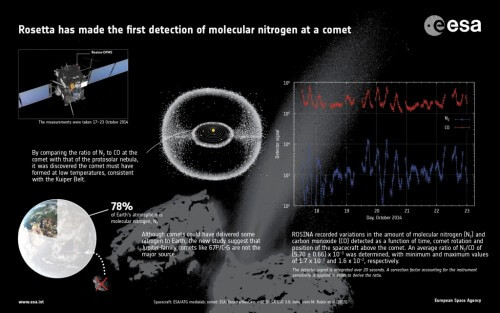The Rosetta spacecraft orbiting the nucleus of comet 67P-Churyumov-Grasimenko has for the first time ever discovered gaseous nitrogen on the surface of a comet. This is a hint about the first stages of the formation of the solar system

The Rosetta spacecraft orbiting the nucleus of comet 67P-Churyumov-Grasimenko has for the first time ever discovered gaseous nitrogen on the surface of a comet. This is a hint about the first stages of the formation of the solar system.
Liquid nitrogen - N2 is the main molecule in the Earth's atmosphere and is also present in the atmospheres and on the surface of Pluto and the Saturnian moon Triton. It is considered the main form of nitrogen appearance in the early nebula from which the solar system was formed.
Martin Rubin, from the Institute of Physics at the University of Bern and his team managed to measure the "most wanted molecule" as Rubin calls it in the halo, or atmosphere, of comet P67-Churyumov-Grasimenko.
This is the first time that scientists have been able to locate nitrogen molecules in a comet. "Although some comets like Churi probably formed in the same regions as Triton and Pluto, until now we have not been able to find nitrogen molecules in them." Robin explains. "Because the water ice on the comet is measured by remote sensing, and the sensitivity and accuracy of the instruments are not satisfactory."
Rubin's team performed the measurements using the Rosina mass spectrometer built by the University of Bern. The device is on the Rosetta spacecraft which arrived at Chori in August 2014 after a ten-year journey in space and has been collecting data on the comet ever since. "Rosin has the necessary resolution to distinguish molecules even if they have almost the same molecular weight, as in the case of carbon monoxide and molecular nitrogen," said Rubin and added. "It's good to see that a device that was designed and built almost 20 years ago is starting to provide data so long after. This is one of Rosina's main measurements." The results of the measurements have now been published in the journal Science.
The nitrogen on Earth did not come from comets
The nitrogen measurements indicate that Churi formed in a very cold region of the solar system. "The amount of molecular nitrogen that reached Israel by comets such as Chori is relatively small compared to other molecules that contain nitrogen such as ammonia." says Rosina's principal investigator, Kathryn Altweg. According to her, these findings add to the evidence that comets from the Jupiter family such as Churi cannot be the main source of both water and volatile substances such as nitrogen on Earth. Altweg and her team recently discovered that the ratio between deuterium and hydrogen in the water on the comet is different from that on Earth, indicating that the water on Earth had a different source. "Like the source of water, the reason for the absence of molecular nitrogen remained an open question during the Giotto mission to Halley's comet almost 30 years ago," she explains. "We are very excited that it can finally be answered."
Matt Taylor, Rosetta's chief scientist, says the discovery of molecular nitrogen is another piece of the puzzle in terms of the role Jupiter family comets have played in the evolution of the solar system. "However, the puzzle is still far from complete," he added. "Rosetta and Churi are now five months before perihelion and we can observe how the composition of the gases changes during the period, and try to assess what this tells us about the comet's previous life."

3 תגובות
Perhaps this nitrogen is measured differently from the nitrogen on Earth, because of the lack of gravity and the strong radiation in space.